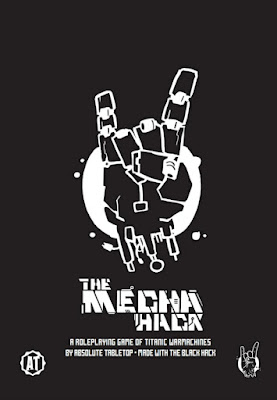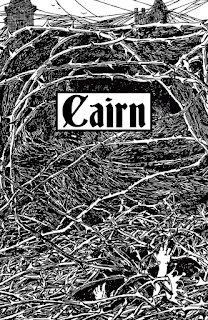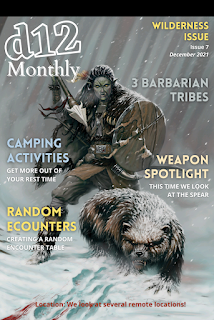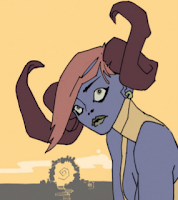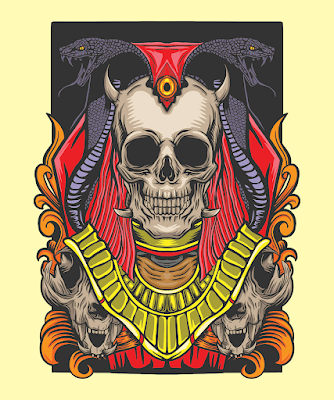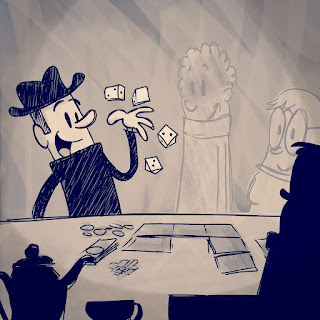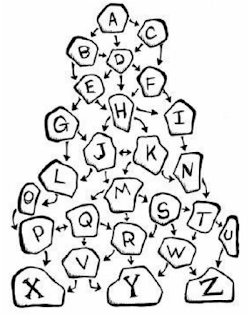Author: Hankerin Ferinale
Engine: Custom d20-based engine
Note: I'm going to start by saying that Hankerin Ferinale delivered on his promises. When he released the new edition of ICRPG this year, one of the first things he did is release a PDF with the updated version of the rules and added it to the library of anyone who has bought Index Card RPG Core 2E from DrivethruRPG. My first look at his new Master Edition was through this updated product. He has followed through on his promise to future-proof every edition of his game when I saw that he had made a contract with Mödiphius and that they would be responsible for releasing the next iteration of ICRPG, I was concerned that wasn't going to happen. Hats off to you, Hankerin.
My review of Index Card RPG Core 2E has to date been the most read review on this site by a factor of three, and the third most read article overall. People are interested in this game and for good reason.
Disclaimer: When I mentioned online that I was wistfully considering buying Viking Death Squad and Index Card RPG Core Master Edition hardcopy, but just couldn't afford Mödiphius; shipping to canada, even with their new us store, hankering decided to sweeten the deal. He sent me PDF copies of both role-playing games for review, can challenge me not to want to buy those games hard copy when I was done. And I am sold. I am now saving up to get myself hard copies of both games. Especially as Viking Death Squad has been an instant hit with my wife, and has become her one-to-one game of choice for the foreseeable future.
So, that begs that I had the caveat to this review that I have been gifted a copy of this manual from someone I have a positive relationship with. I don't think that will bias this review, as it very much repeats many of the points of the previous review, which was written long before I ever personally interacted with Hankerin Ferinale.
The Review
Index Card RPG Core Master Edition is an update to the Index card RPG cCre 2nd edition that I reviewed in 2020. This game that is derived from Dungeons & Dragons and is reasonably intercompatible with it, but it's rules are so streamlined, and in places innovative that it is by no means the same game, and is released under its own license.
And it's heart, Index Card RPG resembles a d20 game. All tasks in the game are assigned a hit point total expressed in increments of 10 called Hearts. Characters roll a d20 and add an appropriate ability score modifier and bonuses added by gear at the character is carrying up to a possible +10.
The roll must beat a Target, a number set for the entire room or encounter by the GM. All things done in the encounter have the same Target. So if you enter a dragon's layer with a Target of 17, picking locks, searching for missing objects, or attacking the dragon and its minions all would require a 17. Monsters have their own stat modifiers for when the GM rolls for them, but they tend to be sparse. Very few monsters have a modifier to defense that makes them harder to hit.
If a roll is successful, some tasks succeed automatically. Others, called Efforts, require time. This is handled by giving every task that requires significant effort a number of hit points expressed in Hearts. So, picking a simple lock might require only one successful roll, a good quality lock might require a full heart of successful rolls, and an exceptional lock might require three or four hearts to undo. Characters have an array of dice for different kinds of tasks (Effort Dice). Doing anything with your bare hands reduces the hip points of a task by a d4. Doing it with a melee weapon or appropriate tools gives a b6. Using explosives or firearms a d8. Using magic or high-tech energy devices a d10. A test with a natural 20 does Ultimate effort adding an exploding d12 to any roll.
This makes the game incredibly consistent. A GM assesses difficulty for the entire room of the Target number, and then the complexity of a task by assigning Hearts. Just like ability scores, effort dice can have modifiers from gear or from the character. A particularly potent magician might have plus two or plus three two the d10 role to determine how well their magic accomplishes attacks. Warrior might add a bonus to weapon and tool damage, for example.
Equipment is the most important thing to determining a character in Index Card RPG Core. The character may carry up to 20 items, and gain the benefit from 10 "equipped" ones, while the others are stored on their person in the way that does not benefit them. Some items just add capabilities to the character. For example, having shovel means your character can dig when they might not be able to otherwise. Other items because of quality, magic, etc add bonuses of up to +3 to an ability score roll or type of effort rule, or grant some sort of unique ability like a magic spell or special move.
A task might be declared particularly Easy or Hard by the GM which applies a plus or minus 3 to the roll. There are also certain conditions under which player characters may be able to reduce the overall Target of an encounter.
Previous editions of Index Card RPG Core were effectively classless and level-less. Characters begin with one Heart and therefore ten hit points, and can only gain hit points in increments of 10 through special items called Heartstone that has to be equipped. An initial selection of a character class granted the character starting equipment that grants a PC extra capabilities. For example, a Mage started with a spell and spell-powering crystals, While a Shadow (thief) started with a cloak that makes hiding easier and a set of thieves tools for picking locks and disarming traps. A Blade, (which is an offensive warrior) gains a kit for maintaining weapons that added to their weapon damage, and a magic gem that increased the damage on one weapon by plus three.
Classes were otherwise simply lists of gear for GM to reward a character when they reach specific milestones along a scene. A custom class to be created simply by changing the list of starting and special reward gear. Classes were essentially vestigial.
This level-less and classless approach has been abandoned slightly by the new Master Edition, however. Characters classes matter in so far as they not only set starting gear, but also grants one of a choice of three special abilities that are independent of year. After rolling 20 natural 20s, the character gains an advanced version of that ability. After that, after an additional 20 natural twenties they gain both another option they did not select and the advanced version of that option. After their 41st through 60th natural 20s, they gain all the remaining special abilities for their class. Classes also continue to have milestone equipment lists that serve as rewards for accomplishing in campaign goals.
A secondary optional character advancement system that was adapted from 2e's ICRPG Magic is also included in the Master Edition. With this system, you choose a specific path your characters on, which lists a number of achievements the character must accomplish. When they have made those achievements, they may select one special character ability unrelated to their class. Once they have gained one of those abilities, they may attempt to gain another from that tier or work on a goal from the next year in the path, which includes more difficult goals, but offers more potent rewards.
This has removed the level-less and classless element from the game to some degree. Characters now have abilities innate to them that cannot be lost or taken away. These remain less significant than the abilities one can gain by finding rare epic level Loot.
It is worth noting that Loot itself is randomly generated whenever characters achieve a objective for their adventure or defeat a creature of three hearts or more. Some Loot may also be placed around the adventure site.
Both versions of ICRPG Core Master Edition include two campaign settings: Alfheim and Warp Shell. Alfheim is a fantasy setting in which human beings are on the brink of extinction and must Ally with other species in order to survive. The setting has been significantly expanded from its original incarnation in ICRPG Core 2e, with more races, classes, and setting specific gear.
Warp Shell is a science fantasy setting inspired by Warhammer 40,000 and, as with Alfheim it has been significantly expanded with new races, classes and abilities.
If you have the Master Edition itself, rather than Master Edition update that was was issued to purchasers of ICRPG Core 2e you will also have Ghost Mountain, a weird west setting, Vigilante City, a superhero setting, and Blood and Snow, a primeval fantasy setting. All of these were originally developed for ICRPG Core 2e in their own sourcebooks. Therefore they are not included in the update for 2nd edition.
As with previous editions, the GM section of ICRPG Core Master Edition is rife with excellent advice on encounter design, simplified adventure planning, effective GM in mindsets, and a list of archetypal encounters and the types of roles they might require. Some of this has been refined to be even better than they considerably impressive GM section of 2e. In other places it's an exact copy/paste.
Encounters in Index Cared RPG Core are expected to be placed on a timer to add pressure. Methods for adding complexity and interest to make ancient counter memorable are excellent. Tools for modifying encounters on the fly to provide challenge to player characters are also provided.
ICRPG is a very fast and light variation on Dungeons & dragons. One can simply grab a monster from an OSR game or early edition of Dungeons & Dragons and run it by granting it the same number of Hearts as it has hit dice, and keeping the Target close to the creatures armor class. ICRPG characters are roughly equivalent to 4th level AD&D characters.
More recent additions of D&D such as 4th and 5th edition can be used by granting a creature number of Hearts equal to its challenge rating divided by 2, then rounded up. Characters are pretty close to 1st or 2nd level D&D 5e characters.
Mechanical Differences Changes
Characters in ICRPG Core Master Edition are slightly more powerful than their second edition counterparts. During character generation in 2e, characters we give in 6 points to distribute amongst attributes, armor, and as bonuses to Effort dice. Now they have six points for attributes, 4 points for effort bonuses, and armor class is equivalent to the Constitution bonus. Very few players wanted to put points into effort or armor when building second edition characters.
Magic is slightly more powerful in Master Edition, using a d10, and guns are granted the d8 position to make them more effective then swords or bows. Tools now Grant a d6 of effort to make using tools better than trying to accomplish a task with one's bare hands, which still does a d4 worth of effort.
As before, the system is extremely fast and easy to learn, although the character advancement systems have added a slightly higher level of complexity to the game.
What I Loved
Speed
I am currently running a Warp Shell campaign for Index Card RPG Master Edition. This game runs fast. Combat encounters, even complex ones, tend to resolve themselves in just a few minutes. You can get a lot of gaming done in a very compact space of time.
Simplicity
Having an openly declared Target number, and a simple consistent mechanic that covers every possible task from saving throws to picking locks to doing battle makes this an extremely simple system to plan for and run.
The Game Master Section
The game master section of
Index Card RPG Core Master Edition is a slight improvement over the already formidable
ICRPG Core 2e game master section. It offers incredible tools for planning adventures, great advice for designing memorable encounters, and tools for adjusting encounters on the fly. It offers a very useful philosophy for approaching game mastery. Having a list of the archetypes of classic dungeon encounters makes planning even simpler.If someone were to ask me to give them sources for the best possible advice on running TTRPGs, I would tell them to get
Index Card RPG Master Edition first, then the
Campaign Guide and Catacomb Sourcebook from
AD&D2e, then finally
XDM: Extreme Dungeon Mastery by Tracy Hickman,
Low power curve
Characters advance a little more notably then they did in icrpg core to e, but character advancement is highly randomized and still mostly based on loot. Characters rarely become invulnerable feeling the way that can in third Edition and later of D&D. Characters never become superheroes. Because characters are also limited to 10 pieces of gear at a time and have a roof of plus 10 to any role, as they do reach the Pinnacle of their ability, they have to literally make trade offs to optimize the roles their character takes in the party. If you are spellcaster, you're going to need to carry magical crystals to fuel your spells, and spell books to contain them all, plus something to enhance your end bonus and your magic effort. That leaves very little room for armor and weapons, for example. And while you might be slightly better towards the end at casting spells then you were in the beginning, the difference is not so great that a one heart monster is not a threat to you.
If a character loses all of their gear, they're left with only a few character class abilities, some of which are gear dependent anyway, and so a character can be reset to nearly beginning level of ability whenever it suits the campaign, which ends itself to a greater level of campaign longevity.
Refined
Icrpg has removed some of the complaints that I had of the previous edition. There's no more hunting for buried rules, everything is a lot more clearly stated. Useless vestigium like weapon tags have been removed from the game. Character death is a little easier to achieve.
Artwork
Hankering fur nails art has come along by strides. He retains the original vibrant, energetic comic book style, but his artwork has become far more detailed and evocative.
Community support
There's lots being created for icrpg, including my own module Harkins slave pit. The runehammer forum is one of the most supportive and energetic online communities I have participated in.
Backward compatible
The material written for second edition remains fully compatible with Master addition, with perhaps the exception of pre-generated characters. Overall, gear for the master Edition has a slightly different numerical character than the loot in second edition, but it will not make a significant difference to actual gameplay..
Future proof
Hankering kept up his promise to keep icrpg future proof offering free updates to existing additions. Andy kept his word. I'm willing to believe he would do the same if he developed a 4th edition of icrpg in the future.
Setting agnostic
While icrpg RPG core Master Edition offers plenty of settings, the game itself is not setting bound. It can easily be adapted almost any genre with only a few simple design choices. The addition of classes has made it a little more labor-intensive to write a new setting for the game, but only slightly so.
Toolkit design philosophy
Much of icrpg core, whatever edition, is designed with modularity in mind. A few of these ideas could easily be pulled out and inserted into other ttrgs.
Hankerin Ferinale
Hey YouTube channel that has some of the best advice for d&d, being very open to talking to other developers and gms, and is dedication to making sure people get the best quality products they can, hankering is one of my favorite people on the Indie TT RPG scene since the covid-19 lockdowns begin, however, his format on YouTube has become too long and involved for me to continue to follow it. That said, I highly recommend his playlist on DM tips and tools for any GM of any level of experience.
Growth points
Introduction of gear independent progression
One of the things I absolutely loved about index card RPG was the fact that if you stripped a character of all their gear, all they might be left with are possibly a couple of wisdom-based divine magic powers, and those are randomly gained. You can effectively hit the reset button on a character simply by taking away gear. And class was nothing but a gear list as well. This made an effectively classless and levelless role-playing game.
By doing this icrpg licked to the biggest problems with Dungeons and Dragons scalability and party balance. Players no longer need to consult with each other about what they're going to play, because they can always find dilutes to fill in roles that they aren't building their characters around. There's no need to make sure there's a cleric in the party when anyone can pick up a healing object.
And by making even classes nothing but gear lists, level was not particularly significant. Characters only attained a certain level of power that was highly manageable. Even a one heart monster with few bonuses remained challenging.
By adding in the random character possession, characters are more locked into a singular role, and they can't be reset to Zero by taking away all of their gear. They will always have some abilities that have become innate to the character. This makes class and level mean a lot more than they did in previous editions, and I do not think that necessarily improves the experience. Overall I would say it's a step in the wrong direction for icrpg.
Gaminess
I written several separate articles on this topic since first running icrpg core to e. Index card RPG owes a lot to video games. In particular, it draws a lot of inspiration from games such as the legend of Zelda and final Fantasy series. This requires a shift in mindset when thinking about how to play. And it is a turnoff for a number of gamers I know. It has made icrpg a bit of a hard sell at times.
Title Confusion
Index Card RPG Core Master Editionis a completely self-contained game that evolved put of Hanketin Furnale's attempts to hack and simplify the DMing process. This started in part with creating a system of dungeon design using illustrated index cards, also called "Index Card RPG:" If you want this game, be sure you are buying the right product.
A word of warning about Warp shell
I started running a science fiction campaign in warp shell rather than designing my own setting, and found it a very difficult setting to use for a space opera more along the lines of traveler. Teleportation, regeneration, self-duplication, and return from Death are all far too readily available in this setting for the kind of stories I was hoping to tell. This game is a surprise in part because the warp show of second edition was not quite the same design. It had a farm more conventional Star warsesque feel to it. This setting has evolved significantly from the second edition.
Conclusions
I'm a huge fan of icrpg as a general purpose role-playing game. If you're looking for something in which to create your own world, run a traditional fantasy game, or just to use an alternative to Dungeons and Dragons, you can't go wrong..
Because of its modularity, it's also very easy to integrate rules such as Dungeons & Dragons style timekeeping, alternate magic systems, or new character class concepts without too much difficulty. It's a perfect platform for hacking new rules in, or taking rules out to hack into your system.
At this point I have run multiple campaigns with multiple groups using icrpg. I would estimate that I have put in nearly 300 hours of play in the system. It is one of my three go-to systems. And I highly recommended if what you are looking for is either a streamlined d&d, a good hacking platform, or a set of alternate rules for a traditional ttrpg.
